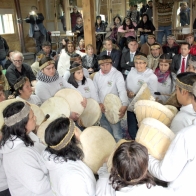In recent years the Chilean state has made strides towards including Indigenous education in the national curriculum. In 2018 the Ministry of Education conducted an Indigenous Education Consultation to identify core themes and competencies to be included in a relevant and accurate Indigenous Curriculum. Despite efforts, this process of development and scale-up has been slow and classrooms across the country still lack a relevant curriculum to allow people to engage with the true history and traditional knowledge of the Indigenous peoples of the region.
The development of ‘
Wekimün’: A School for and with Indigenous Youth and their Communities is the outcome of a six-year, education for sustainable development project, based in the archipelago of Chiloé, Chile. This work was led by the
Young Lives Research Lab (Canada) and the Williche Council of Chiefs of Chiloé, with funding from Global Affairs Canada. The project worked directly with the Indigenous Williche communities to identify the community’s needs and hopes for their futures. It then went on to develop and implement a curriculum and a school, based in traditional, Indigenous Williche knowledge. The word
wekimün means ‘new knowledge’ in the Williche language of Mapudungun. This concept guided the process of developing a unique, intercultural curriculum through decolonized, trans-disciplinary, intergenerational community-based methods.
While infrastructure provided a necessary base for school operations and community engagement and participation,
Wekimün Chilkatuwe (school) was designed as a school without walls. Community informed, project-based learning guides each of the curricular areas. These include: the traditional language (Mapudungun); Williche culture and cosmovision education; traditional agriculture; Williche cooking and nutrition; human and Indigenous rights; and gender equity; and sustainable development. Students developed projects with and for their communities and engaged peers, family, children, and elders in the process of teaching and learning. They connected with the people, land and sea of their territories and identified human and natural resources and opportunities for sustainable community development.
Students described their experience at Wekimün Chilkatuwe as a ‘rebirth’ that connected them deeply to their families and communities and made them proud of their Indigenous heritage. Students and community members widely discussed the school as a tool for breaking down hundreds of years of discrimination, prejudice, and cultural shame. This education model provided the steppingstones towards truth and reconciliation for the Williche communities of Chiloé as they were offered, for the first time, an opportunity to identify, restore, and preserve their history, culture, traditions and knowledge.
We have much to learn from traditional Indigenous knowledge and ways of being, becoming and belonging. More than 1000 students and community members participated in ‘Wekimün Chilkatuwe’ educational activities during the project implementation and the school continues to offer many opportunities for understanding ways in which we can reimagine education with, for, and by Indigenous peoples. The success of the
Wekimün Chilkatuwe project prompts three questions:
- ‘How can what has beenlearned through Wekimün be applied to broader educational systems’?
- As we work towards the UN ESD goals for 2030, what might scaling-up proveneducationalreforms,likeWekimün, look like?
- How might these changes be implemented for young people and life-long learners everywhere
Dr. Kate Tilleczek
Scientific Director, Young Lives Research Laboratory (CANADA)
Professor and Canada Research Chair (Youth, Education & Global Good)
York University, Department of Education
